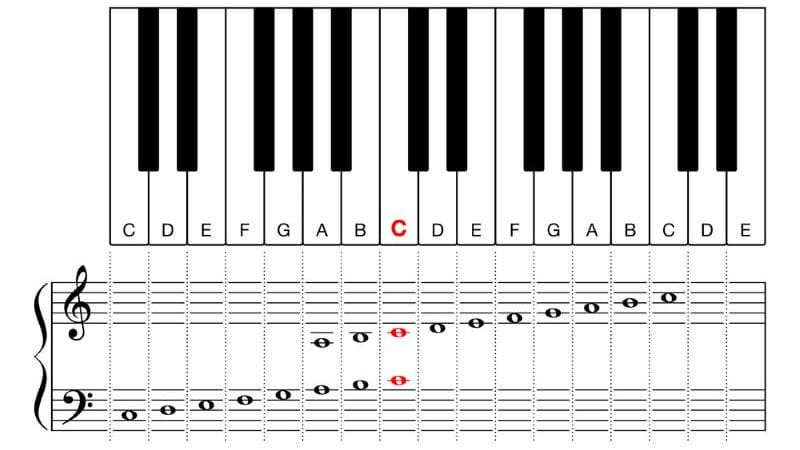This article will introduce you to the notes names of the ukulele strings, understand the difference between major and minor scales, and know how to play a major C scale on the ukulele.
Written by Shaylie M / Published September 6, 2024
Last updated: September 2, 2024

Music theory can be described as the basic fundamentals that create a universal language among musicians.
Some of the most famous classical musicians, such as Bach or Beethoven, were experts in musical theory. These prodigies were able to grasp deep musical concepts that allowed them to create masterful works incorporating a multitude of instruments and musical elements.
Having a basic understanding of the ukulele music theory will help us to make music, work with the instrument, and develop our musical skill set.
Ukulele String Note Names
One of the best places to begin our ukulele musical theory is with identifying and memorizing the ukulele string names.
Standard Tuning
The names of the strings on the ukulele are G, C, E, and A. The G is labeled as the fourth string, which will be the string on the left when looking at the ukulele across from you. The next string, or third string, is a C. Then the second string is an E and the first string is an A.
An easy way to remember these note names is to use an mnemonic device, which is a silly phrase to help us remember these note names.
An example of a commonly used way to remember these note names is “Good Cats Eat Anchovies” or maybe “Great Cheetahs Exercise Acceleration”.
We want to memorize these note names because they will be used any time we need to tune the ukulele. Over time, ukuleles can lose their tune, often due to changes in weather such as precipitation, temperature, or humidity.
These weather fluctuations cause the strings to ever so slightly lengthen or tighten, changing the tune of the string. If a ukulele has newer strings it will go out of tune more quickly because the strings are not yet stretched to their full capacity.

What Is An Interval?
Definition
Interval is the space or distance between two notes.
Between notes there are different steps or spaces which can create different songs and melodies based on how far apart the notes are (sonically speaking and physically speaking on the ukulele). The two most basic steps to begin learning are whole steps and half steps.
Whole Steps and Half Steps
A half step is the smallest musical interval or space between two notes. You may also hear it referred to as a semitone. On the ukulele, this corresponds to notes that are only one fret apart.
A whole step is two half notes, however, it is going to have a sound that feels more resolute to the ear. You may also hear these referred to as a tone, and they are two frets apart on the ukulele.

But what does this mean for us practically speaking?
An Introduction to Scales
In its most basic sense, applying half and whole steps to the ukulele will help us understand how to construct and play scales. A scale is simply a series of notes, or intervals, arranged in a particular order of pitch.
The Major Scale
Most beginner pieces of music are going to be built on what is called the major scale. Major scales have a specific sound that most often leads to the creation of music that sounds positive, upbeat, or happy.
A major scale has a very specific pattern of whole and half steps.
Whole – Whole – Half – Whole – Whole – Whole – Half
Shortened this could be notated: W-W-H-W-W-W-H
The Minor Scale
In music theory, the opposite of a major scale is called the minor scale, which tends to be used in music that sounds sad, bittersweet, or even melancholy.
Similarly, the minor scale has a specific pattern of whole and half steps.
Whole – Half – Whole – Whole – Half – Whole – Whole
Shortened this could be notated: W‑H‑W‑W‑H‑W‑W
If we want to get really technical, there are three different minor scales in music theory. For our purposes, we are only discussing the natural minor scale in this example.
While there is value in understanding and knowing both types of scales, we are going to take a closer look at the major scale in this article.
Learning the C Major Scale on Ukulele
Let’s begin by learning how to play a C major scale on the ukulele. To play this scale, the notes are going to be all natural. This means that none of the notes will have a sharp or a flat.
Another way to think about this is to picture a piano keyboard. The white keys are the natural notes, and the black keys are the sharps and flats. The C major scale uses only the white keys, and none of the black keys.

Notes in the C Major Scale
The scale will use these notes: C – D – E – F – G – A – B – C
If you noticed the notes started back over to A after getting to G, good observation! The musical alphabet only has 7 letters. Once we reach the letter G, we start back over at A.
To start, we will begin by playing open C on the ukulele. When you hear the term “open”, this means there will be no fingers pressed on that specific string on the fretboard.
Playing the C Major Scale on Ukulele
We will begin by playing an open C.
1. To play an open C, we will play the third string on the ukulele without pressing down on any of the frets.
2. Next in the scale is D. We will play the third string with our first finger on the 2nd fret.
3. Now we will play another open string on the note E, or the second string.
4. To play note F, we will play the second string by placing our first finger firmly on the first fret.
5. To move onto G, we will play the second string with our second finger on the third fret.
6. To play note A, we will play the first string open.
7. To play note B, we will press on the 2nd fret of the first string.
8. And lastly, we will complete our scale by pressing our second finger firmly onto the third fret of the first string, playing a C again.

Conclusion
Ukulele music theory can get very detailed and in depth but you just learned some of the basics! After reading this article, you should be able to name the names of the strings on the ukulele, explain a major or minor scale, and play a C major scale.
Let us know what other music theory topics you’d like us to dive into, or things you’ve discovered on your ukulele that you’d like an explanation for.

Shaylie M
WriterShaylie has shared a love for music for as long as she can remember. Since completing her degree in Music Education, she has quickly found the ukulele to be her favorite instrument to teach her young students in her role as an elementary music teacher.




